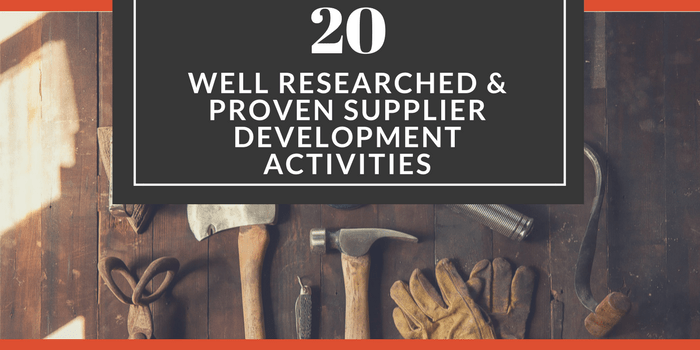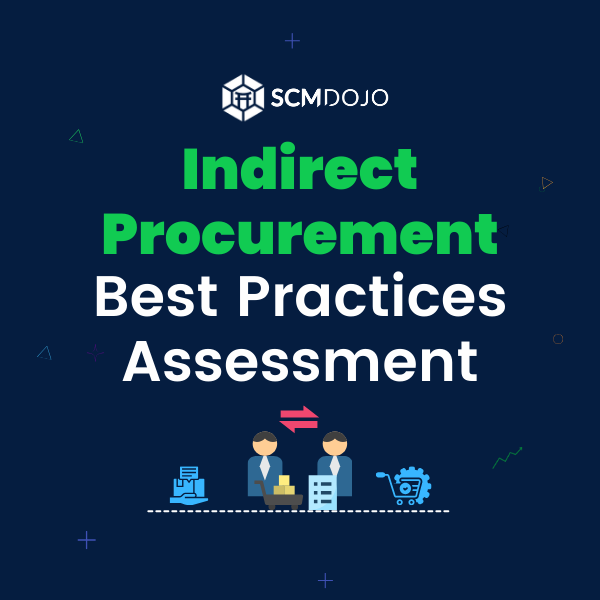The subject of supplier development activities, practices, and success factors is researched in 36 out of the 81 articles I have researched. Therefore this makes it the most frequently discussed subject in the topic of supplier development. Various types of supplier development activities and resources exist and are mentioned by many researchers, some of which require an intensive. This list of supplier development activities is classified as Direct (D) or Indirect (I) activities, their definitions are discussed in this blog.
During my research only one article, by Krause and Scannel (2002), compare the supplier development activities between product and service firms, concluding that product based firms used supplier evaluation and feedback, and supplier incentives to a greater extent than the service firms. On the other hand, they found that the service firms used competitive pressure to a greater extent than the product based firms.
20 Supplier Development Activities and Contributing Researchers
| No. | Activity | D/I | Authors |
| 1 | Competitive Pressure | I | Krause et al. (2000) |
| 2 | Parts standardisation | I | Sanches-Rodriguez, et al. (2005) |
| 3 | Formal supplier evaluation | I | Forker and Hershauer (2000); Forker et al. (1999); Krause (1997); Sanches-Rodriguez, et al. (2005); Carr and Pearson (1999); Krause et al. (2000); Hahn et al. (1990); Hines (1994) |
| 4 | Requiring supplier capability improvement | I | Krause and Ellram, (1997a); Humphreys et al. (2007) |
| 5 | Enhancing working relationship with suppliers | I | Krause and Ellram, (1997b); Kannan et al. (2010); McGovern and Hicks (2006); Modi and Mobert (2007); Krause and Ellram, (1997a) |
| 6 | Use of supplier certification programme | I | Forker and Hershauer (2000); Forker et al. (1999); Krause (1997); Sanches-Rodriguez, et al. (2005); Kannan et al. (2010); Modi and Mobert (2007); Krause and Ellram, (1997b); Krause (1999) |
| 7 | Supplier recognition | I | Humphreys et al. (2004); Krause and Ellram, (1997b); Krause and Ellram, (1997a); Krause (1997); Sanches-Rodriguez, et al. (2005) |
| 8 | Clarity of specifications provided to suppliers by customers to manage risk | I | McGovern and Hicks (2006) |
| 9 | Extension of long-term contracts | I | Krause and Ellram, (1997b); Rodriguez, et al. (2005); |
| 10 | Top management support | I | Hahn et al., (1990); Krause and Ellram, (1997b); Humphreys et al. (2004); Krause (1999); Modi and Mobert (2007); Krause and Ellram (1997a) |
| 11 | Effective communication | I | Krause and Ellram, (1997b); Kannan et al. (2010); McGovern and Hicks (2006); Modi and Mobert (2007); Krause and Ellram, (1997a); Prahinski and Benton (2004); Rodriguez, et al. (2005) |
| 12 | Establishing Trust | I | Kannan et al. (2010); Humphreys et al. (2007); Humphreys et al. (2004) |
| 13 | Increasing performance goals | D | Monczka et al. (1993); Humphreys et al. (2004) |
| 14 | Site visit to supplier | D | McGovern and Hicks (2006); Krause and Ellram, (1997b); Prahinski and Benton (2004); Krause and Ellram, (1997a) |
| 15 | Visits to the buying firm by the supplier’s representatives | D | Krause and Ellram, (1997a) |
| 16 | Supplier education and training of personnel | D | Krause and Ellram, (1997a); Krause et al. (2000a); Prahinski and Benton (2004); Krause and Ellram, (1997b); Kannan et al. (2010) |
| 17 | Investment in supplier’s operations and equipment | D | Krause and Ellram, (1997b); Kannan et al. (2010); Modi and Mobert (2007); Krause and Ellram, (1997a); Humphreys et al. (2004); Humphreys et al. (2007); Krause (1999) |
| 18 | The provision of incentives for continuous improvements | D | Humphreys et al. (2004) |
| 19 | Supplier organisational integration | D | McGovern and Hicks (2006); Modi and Mobert (2007) |
| 20 | Involvement of suppliers in the buyer’s new product development | D | Humphreys et al. (2007) |
Other Important Findings about Supplier Development Activities
I have also noted that the research article focusing on supplier development activities lacks in-depth frameworks on how to select appropriate supplier development activities, from the many alternatives available, to achieve the desired result. Therefore there is a research gap to establish the direct or indirect impact of selective supplier development activities on suppliers’ cost, quality, delivery and production innovation, and to determine how supplier developmet links with improvements in the buying firm’s performance. Buying firms would then better understand which supplier development activities is required to achieve a desired outcome and which supplier development activities they need to focus on to acquire excellence.
Although this issue is not yet fully answered in the literature, the following papers make a contribution to it. Trent and Monczka (1999) present a hierarchy of activities in their descriptive article addressing the increasing importance of the supplier, particularly in supporting product and service quality requirements.
Carr and Kaynak (2007) and Chidambaranathan et al. (2009) investigated the relationships amongst various supplier development activities such as use of communication methods, information sharing within a firm, information sharing between firms, supplier development support (visits and training), supplier evaluation and capability improvement. Similarly Prahinski and Benton, (2004) investigated supplier evaluations and communications strategies to improve supplier performance and have found that the buying firm cannot expect supplier performance to improve by simply establishing the supplier development procedures.
Research conducted by Kannan et al., (2010) also analysed the interactions among various supplier development activities in the automobile industry and have found that firms are increasingly thinking in terms of competing as a part of a supply chain against other supply chains, rather than as a single firm against another individual firm.
Summary
All these research papers attempt to understand the relationships of various supplier development activities in various business settings. Now it is up the supply chain practitioner to select the ones which benefits their business most and achieved required supplier performance improvement goal.
The fascinating thing about this list of 20 supplier development activities it is its versatility; although these are “common” supply chain activities, everyone—not only supply chain professionals—can successfully leverage them, and on a wide set of challenges. So as you read this article and go through the supplier development activities, I encourage you to take mental (or physical) note of these activities and incorporate them in your personal & professional toolkit as you face other tasks and challenges in your company’s life.
Now, what are you waiting for, select the 5 you like and apply! And then next 5……
Recommended Reading
Key Success Factors for an SME Supplier Development Program
About the Author- Dr Muddassir Ahmed
Dr MuddassirAhmed is the Founder & CEO of SCMDOJO. He is a global speaker, vlogger and supply chain industry expert with 17 years of experience in the Manufacturing Industry in the UK, Europe, the Middle East and South East Asia in various Supply Chain leadership roles. Dr. Muddassir has received a PhD in Management Science from Lancaster University Management School. Muddassir is a Six Sigma black belt and founded the leading supply chain platform SCMDOJO to enable supply chain professionals and teams to thrive by providing best-in-class knowledge content, tools and access to experts.
You can follow him on LinkedIn, Facebook, Twitter or Instagram







